Key takeaways:
- Choosing the right lens significantly impacts the mood and intimacy of portrait photography, affecting how subjects are perceived.
- Aperture and focal length are critical features to consider, as they influence light intake and perspective in portraits.
- Experimenting with different lenses can reveal emotional depth and storytelling potential in photographs.
- Building a connection with subjects and being mindful of background and angles enhances the overall quality of portrait images.

Photography lens overview
When we talk about photography lenses, it’s like choosing the right tool for a craft. I remember the first time I picked up a lens—it was a prime 50mm, and the clarity it brought to my portraits was breathtaking. Each lens has its unique characteristics, whether it’s the compression of a telephoto or the wide perspective of a wide-angle, which can transform a simple shot into something exceptional.
Understanding the different types of lenses is crucial for any photographer. Are you capturing individual portraits or working with groups? I’ve found that the choice of focal length can significantly alter the mood and intimacy of a photo. For instance, a longer focal length helps create beautiful background blur, isolating the subject and drawing the viewer’s eye straight to their expression, while a wider lens can include more of the environment which tells a richer story.
Moreover, the aperture of a lens plays a pivotal role in portrait photography. It’s fascinating how a lens that opens up to a wide f-stop can let in more light and create that dreamy bokeh effect that many of us adore. Have you ever noticed how the right bokeh can evoke a certain emotion or mood in your portraits? I certainly have, and it always leaves me pondering the possibilities of each lens I own, wondering what stories they will help tell in the next shot.
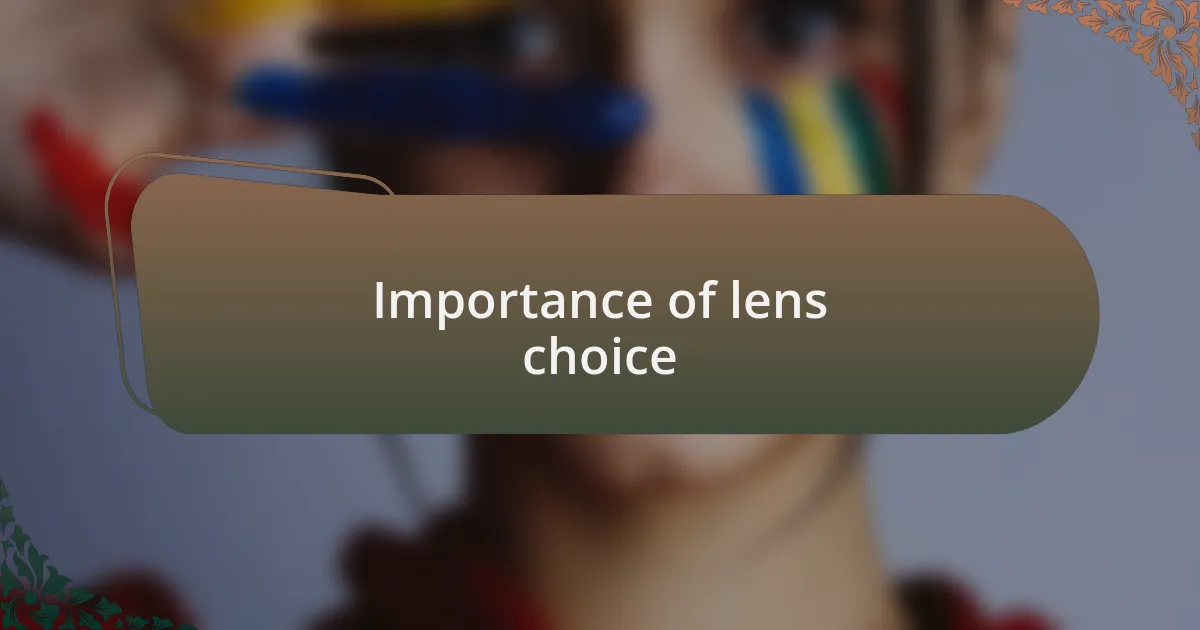
Importance of lens choice
Choosing the right lens can truly make or break a portrait. I learned this firsthand during a recent shoot when I swapped my usual 85mm for a 35mm lens. The closer perspective introduced an unexpected intimacy that really connected the viewer to my subject’s emotions, something I hadn’t anticipated. Have you ever considered how a lens choice can alter not just the image but also the feelings captured within it?
The versatility of your lens can dramatically shape your storytelling. I often think back to a family session where the right lens allowed for both candid moments and more structured poses. With a 50mm lens, I was able to effortlessly navigate these scenarios, capturing emotions in a natural way. Don’t underestimate how lens choice can enhance the narrative you’re trying to convey; it’s like giving your subjects a voice.
Ultimately, the lens forms a relationship with the subject. I recall a portrait of an elderly man, shot with a longer focal length, which not only isolated him beautifully but also highlighted the depth of character etched into his features. Isn’t it incredible how a single change in lens can transform the connection between the photographer, the subject, and the audience? Each lens tells a story; the key is knowing which story you want to tell.
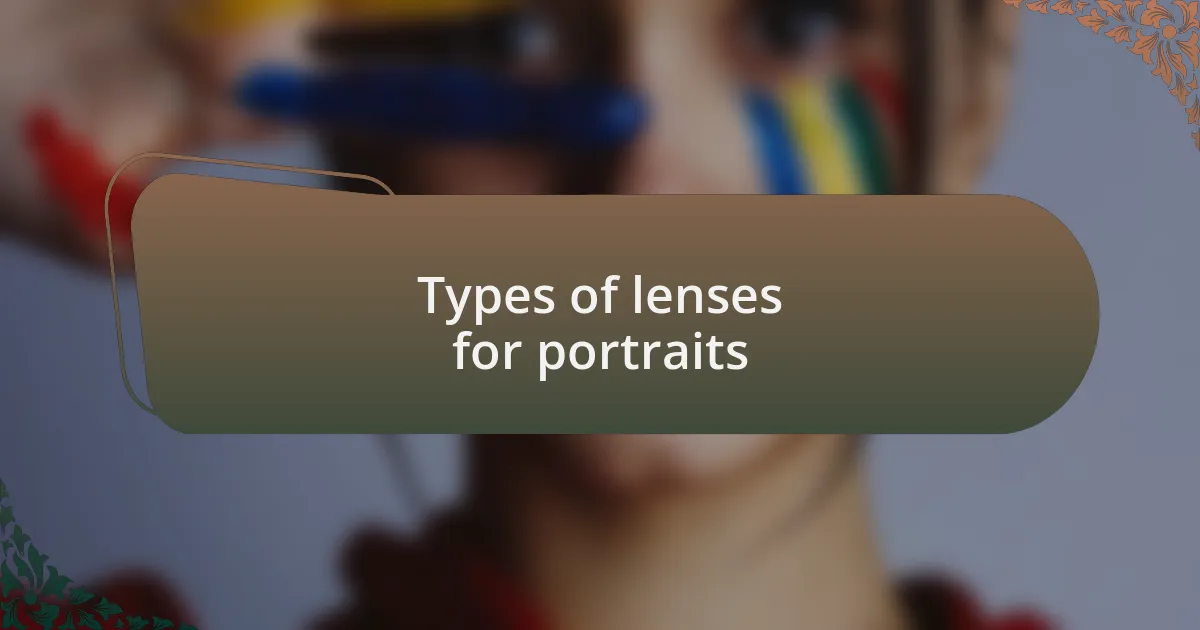
Types of lenses for portraits
When considering lenses for portrait photography, the classic 85mm has long been my go-to choice. In a recent session, I felt the magic of its compression, which beautifully flattered my subject’s features. The way it effortlessly blurred the background while keeping my focus sharp truly transformed the portrait into an emotional experience. Have you ever noticed how certain focal lengths seem to make your subjects shine?
On the other hand, a 50mm lens offers a wonderful middle ground. I remember using it during an outdoor engagement shoot; its versatility allowed me to create both close-up and wide shots without losing intimacy. It was fascinating to see how the surrounding environment could enhance the story without overwhelming the subject. It creates an almost candid feel, drawing viewers into the moment. Isn’t it liberating to have such flexibility at your fingertips?
Let’s not forget about wide-angle lenses for environmental portraits. I once captured a musician in a bustling café, utilizing a 24mm to incorporate the vibrant surroundings. The lens choice allowed me to portray not just the artist, but the essence of their creative space, creating a narrative that no standard focal length could achieve. How can something as simple as a lens choice bring a portrait to life and tell a deeper story?
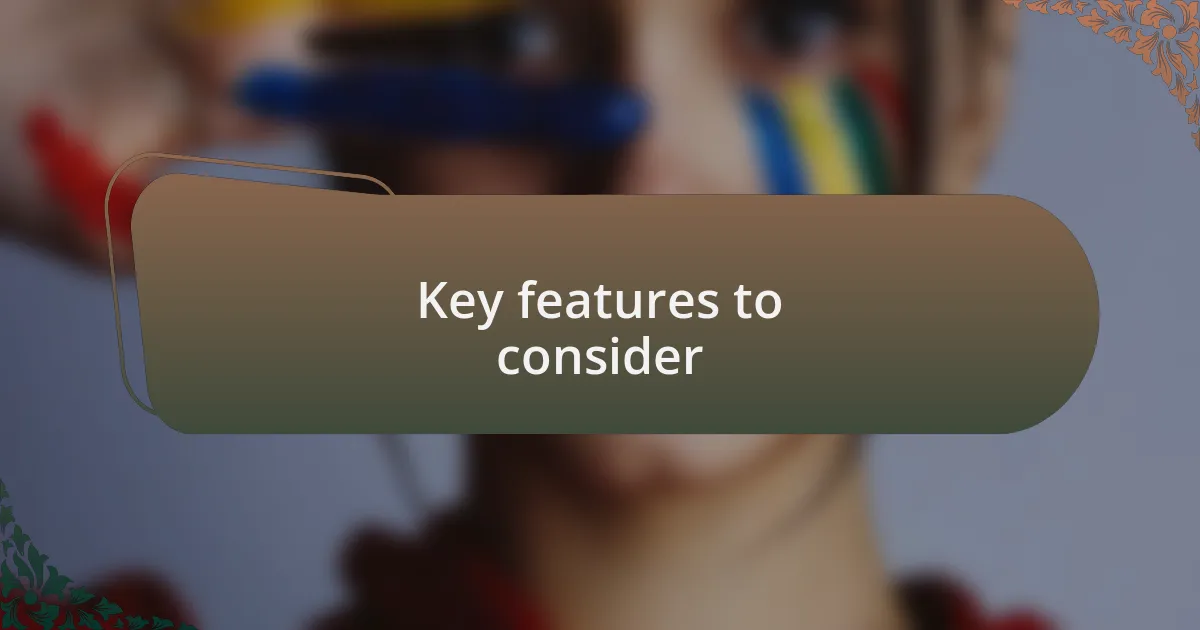
Key features to consider
When choosing a lens for portraits, one essential feature to consider is aperture. A wider aperture, like f/1.8 or f/1.4, allows for more light to enter, creating that gorgeous, creamy background blur I love. I remember a quiet afternoon spent taking headshots with my 85mm f/1.8; the way it isolated my subject made each shot feel intimate, allowing their personality to shine through. Have you ever wondered why some portraits evoke stronger emotions than others? Well, often it’s the lens’s ability to separate the subject from the chaos behind them.
Another critical factor is the focal length, as it greatly influences perspective and depth. With longer focal lengths, like 135mm, you get flattering compression, which, in my experience, can dramatically improve the look of facial features. During a family portrait session, using a 135mm lens helped capture the warmth in their smiles without distortion, creating a timeless feel. Isn’t it fascinating to think how the right focal length can transform a simple photo into a cherished memory?
Lastly, take into account the build quality and weight of the lens. I recall a day spent shooting portraits in a bustling city, and my lightweight 50mm lens felt like a true companion. I was able to maneuver easily through crowds without fatigue, allowing me to focus entirely on capturing those fleeting moments. Might the weight of your gear affect your creativity and spontaneity? In my experience, a more manageable lens opens up opportunities for capturing candid shots that often tell richer stories.
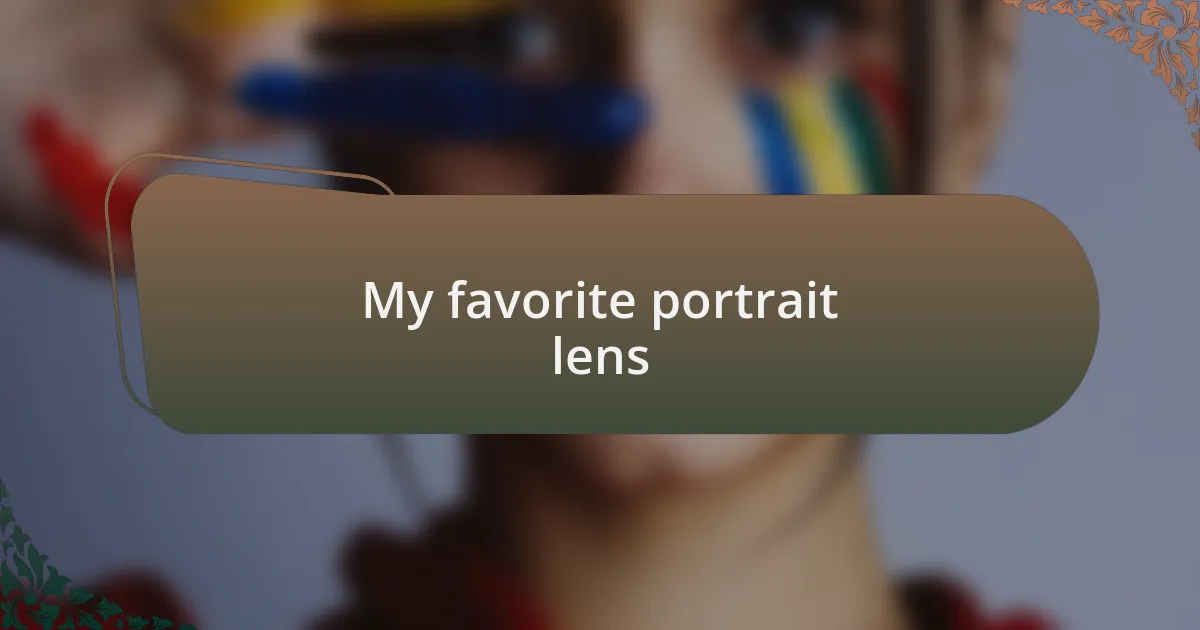
My favorite portrait lens
My favorite portrait lens is definitely the 85mm f/1.4. It has this incredible ability to render skin tones beautifully, making every subject look vibrant and alive. I vividly recall a photoshoot with a friend under golden hour light, where the lens just melted the background away and transformed the scene into pure magic. Can you imagine how different that portrait would have felt with a lesser lens?
Another gem in my kit is the 50mm f/1.2. This lens strikes a balance between versatility and artistry. I love using it in tight spaces, where I can get close enough to my subjects while still capturing the environment around them. One time, I had an impromptu session at a quaint coffee shop, and the lens allowed me to create intimate portraits amidst the lively atmosphere. Don’t you think it’s amazing how a single lens can shape your entire creative experience?
Of course, I have a soft spot for the classic 35mm f/1.4, especially for environmental portraits. I enjoy how it gives context to the subject, weaving their story into the frame. I remember taking portraits of a musician in her studio, and the lens beautifully captured the essence of her artistic space. How does it feel when a lens not only showcases a person but also narrates their journey? For me, that’s what photography is all about—creating connections that resonate long after the shutter clicks.
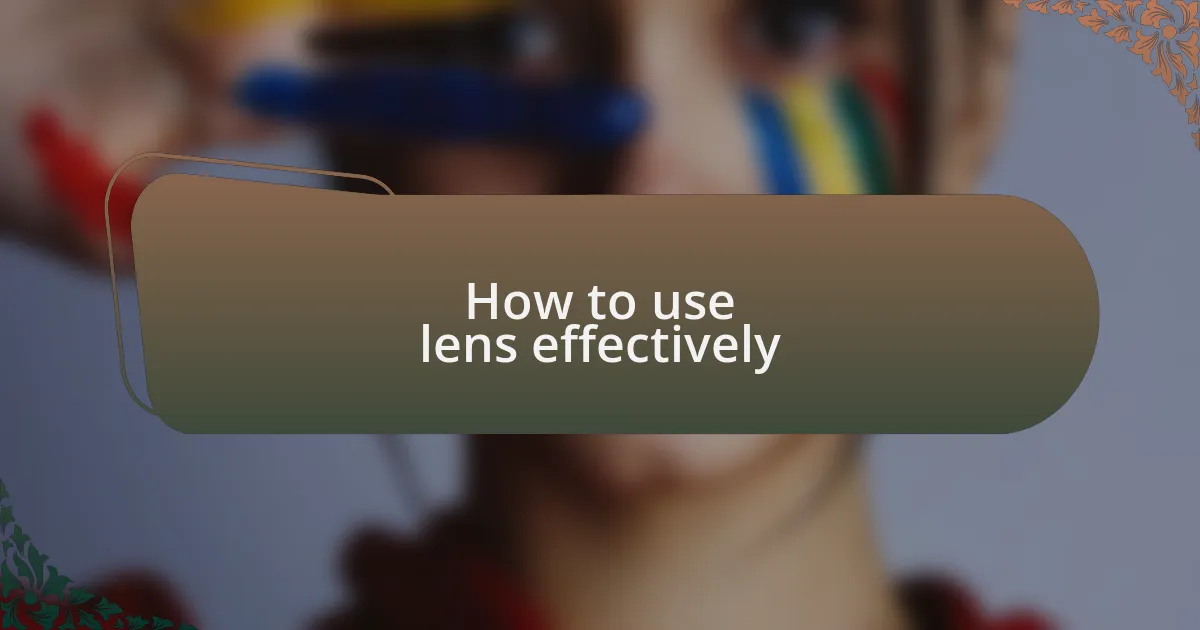
How to use lens effectively
Using a lens effectively isn’t just about choosing the right specifications; it’s about understanding how to manipulate its unique characteristics in various settings. For instance, I remember a time when I took my 85mm lens to a bustling street festival. The ability to isolate my subject from the chaotic background made those images sparkle, transforming a busy scene into a portrait of pure emotion. Isn’t it interesting how a slight adjustment in framing can tell an entirely different story?
When shooting portraits, mastering depth of field can elevate your work significantly. I often experiment with wide apertures, and I recall a portrait session where I opened up to f/1.4. The creamy bokeh behind my subject created a soft backdrop that not only highlighted her features but also elicited an intimate mood. Can you feel the difference that subtle change makes? It’s moments like these that reveal the power of lens choices in expressing emotion.
Don’t underestimate the impact of lighting in conjunction with your lens. I once captured a portrait during golden hour with my 50mm f/1.2, and the warm sun kissed my subject’s face just right, combining with the lens’s sharpness to produce an almost ethereal glow. This experience reminded me that understanding both the lens and the lighting can truly make or break your shot. What settings have you discovered that transform your images in unexpected ways?
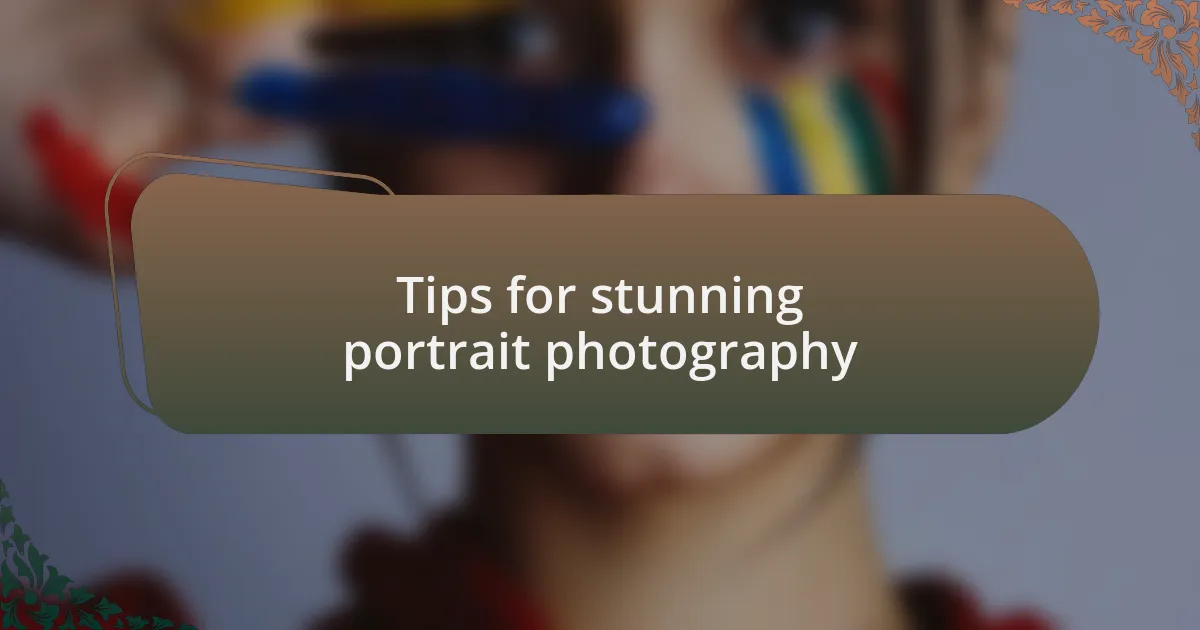
Tips for stunning portrait photography
When capturing portraits, remember that the background plays a vital role in storytelling. I once shot a formal portrait against a crisp, spartan backdrop, and the simplicity allowed the subject’s personality to shine through. Have you ever considered how a cluttered setting might distract from the essence of your subject?
Taking time to connect with your subject can also transform your portraits. I vividly recall a session where I spent the first few minutes just chatting with my subject, easing her nerves. The genuine smiles and relaxed expressions that emerged from this small effort made all the difference—sometimes, it’s those authentic moments that speak volumes.
Don’t forget the power of angles and perspectives. I often experiment with unconventional angles; one time, I shot from a low perspective, which gave my subject an air of confidence that was palpable. Isn’t it fascinating how a shift in viewpoint can drastically change the narrative of a portrait? It’s like finding hidden stories waiting to be uncovered in each unique pose.